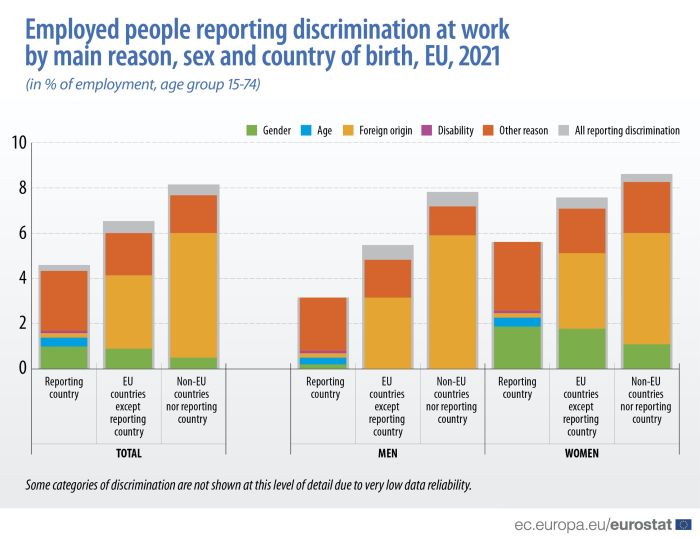Self-perceived discrimination at work - statistics
Data extracted in October 2022
Planned article update: 2030 (with the availability of LFS 2029 module)
Highlights
In 2021, 5.23 million women in the EU reported feeling they were being discriminated against at work. Far fewer men, 3.63 million, reported the same.
In 2021, 7% of people employed in human health and social work activities across the EU said they had experienced discrimination at work.
This article is about the negative discrimination that people report feeling in their current jobs. The article looks at several reasons for discrimination: gender, age, foreign origin, disability as well as other reasons.
The data used in the article come from the 8-yearly regular module of the Labour Force Survey (EU-LFS) on the labour market situation of migrants and their immediate descendants held in 2021. While this module of questions focuses on foreign-born people and allows analysing their situation and those of their immediate descendants in the labour market of their country of residence, some information was collected for all the population 15-74 years old including on the feeling of being discriminated at work. The statistics presented cover the European Union (EU) as a whole and its individual Member States, as well as two EFTA countries (Norway and Switzerland).
Full article
Women more discriminated against than men
In 2021, 5.23 million women in the EU reported feeling they were being discriminated against at work. Far fewer men, 3.63 million, reported feeling discriminated against. This is mainly because more women than men report feeling discriminated against on the grounds of gender: 1.62 million women versus 0.15 million men, or around 10 times more women than men (see Figure 1).
More women than men also reported having felt discriminated against at work on the grounds of age (0.37 million women versus 0.31 million men) and disability (0.11 million women versus 0.09 million men), whereas more men than women reported having felt discriminated against on the grounds of foreign origin (0.81 million men versus 0.59 million women).
The largest group of people who reported feeling discriminated against was the group that reported feeling discriminated against on grounds other than gender, age, foreign origin or disability. This group had 2.27 million men and 2.55 million women in it. The exact reason for discrimination against those people is unknown, however, some countries reported the inclusion of additional categories of discrimination in their national questionnaires to respond to their country’s needs for information, e.g. “physical appearance”, “sexual orientation”, “union affiliation”, etc. Subsequently, collected information on those additional categories has been transmitted to Eurostat under the category “other reason”.
The people surveyed gave only the main reason for discrimination: there might be more than one reason, but the survey concerns only what people perceive to be the main one.
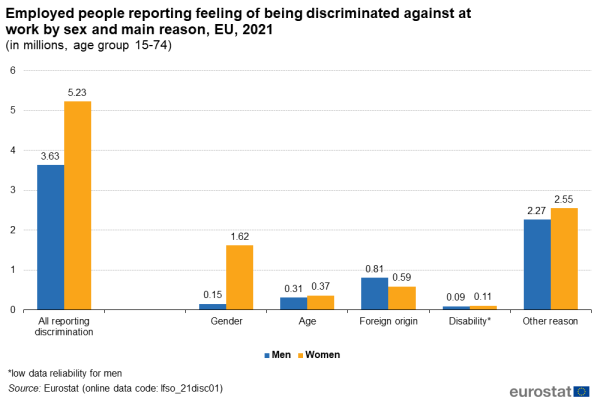
Source: Eurostat (lfso_21disc01)
The overall proportion of employed women reporting feeling discriminated against at work was 6.1 % in the EU in 2021. The highest percentages in EU countries were recorded in Luxembourg (17.2 %), France (11.2 %) and Portugal (10.6 %) - see Figure 2, bars marked with a grey line, encompassing all reasons for discrimination. In Norway, 13.3 % of employed women reported feeling discriminated against at work, while in Switzerland 9.3 % of employed women reported feeling this was the case. By contrast, the only countries with percentages below 1 % were Hungary and Romania. Regarding the reasons for discrimination, the situation for women at country level varies. However, in most countries discrimination on the grounds of gender was the most common or second most common reason employed women gave for discrimination (dark blue bars).
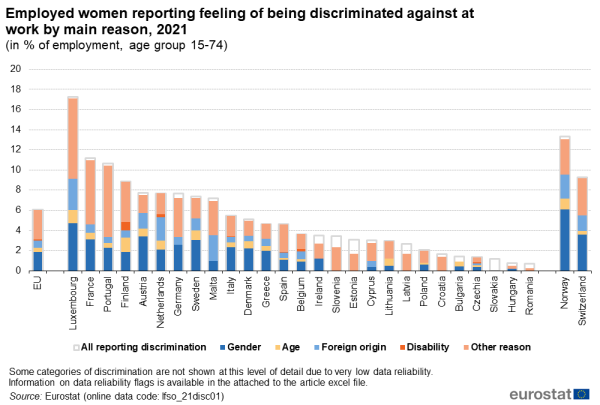
Source: Eurostat (lfso_21disc01)
The proportion of employed men reporting feeling discriminated against at work in the EU was 3.6 % in 2021. The highest proportions in EU countries were recorded in Luxembourg (13.4 %), France (6.9 %) and Portugal (6.2 %), see Figure 3. This high percentage in Luxembourg for men but also as previously shown for women, particularly for the category “other reason”, might be a consequence of the country specificities, such as a high proportion of people with foreign background living in the country for already a couple of generations. The lowest proportions in the EU, less than 1 %, were recorded in Bulgaria, Czechia, Romania and Hungary. As for women, Norway and Switzerland (6.2 % for both) also had a relatively high proportion of men reporting feeling discriminated against at work. In most countries with available data, the most common reason for discrimination against men was a reason other than gender, age, foreign origin or disability (pink bars), followed by discrimination on the grounds of foreign origin (light blue bars).

Source: Eurostat (lfso_21disc01)
In all countries, the proportion of employed women who had experienced discrimination (total of all reasons) at work was higher than the corresponding proportion of men, as Figure 4 shows. Finland, Portugal, France and Norway recorded the highest difference between both percentages, of more than 4 percentage points.

Source: Eurostat (lfso_21disc01)
How the proportion of people reporting discrimination changes depending on their age and level of education
Comparing different age groups, the proportion of employed people in the EU who had reported feeling they were being discriminated against at work was the highest among 30-54-year-olds and 55-74-year-olds. It was the lowest for 15-29-year-olds (Figure 5). This pattern is the same for both men and women. In terms of both sex and age at EU level, the proportion of employed people who felt they were being discriminated against at work ranged from 6.3 % for 30-54-year-old women to 2.6 % for 15-29-year-old men.
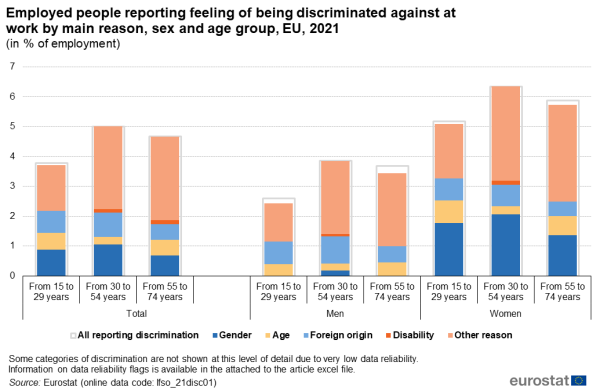
Source: Eurostat (lfso_21disc01)
Different patterns occur for employed men compared with employed women according to their level of education, as shown in Figure 6. The percentage of men reporting discrimination at work was the highest for those with a low level of education (4.1 %), it fell for those with a medium (3.4 %) and slightly increased for those with a high level of education (3.9 %). For women, the higher the level of education, the more they are discriminated against at work: 5.0 % of women with a low level of education discriminated against; 5.5 % of women with a medium level of education, and 7.2 % of women with a high level of education. Figure 6 focuses on people’s educational attainment level, so it zooms in on the 25-74 age group, i.e. excluding student age groups under 25.
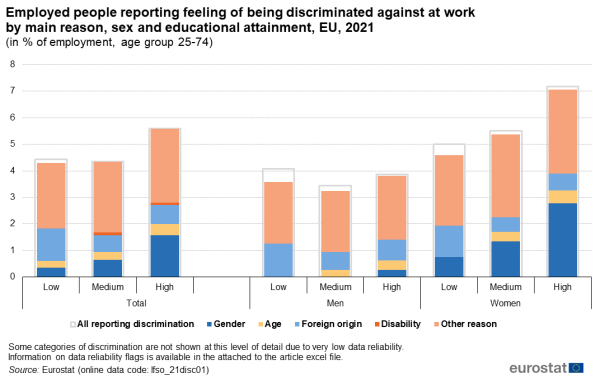
Source: Eurostat (lfso_21disc01)
As analysed above, the proportion of employed women reporting feeling they were being discriminated against at work was higher than that of employed men, for all age groups and levels of education. This was mainly because of the substantially higher percentage of women reporting discrimination at work on the grounds of gender. Another relevant finding about the proportion of women facing discrimination at work because of their gender is that it increases with the increase in the level of education (the dark blue bars on the right side of Figure 6).
The proportion of employed people reporting feeling discriminated against at work on the grounds of foreign origin is also affected by the level of education: people with a low level of education are discriminated against more than people with medium or high levels of education. This holds for both men and women (the light blue bars of Figure 6).
… and from the country of birth perspective
People born in the reporting country, but with both parents born abroad, had the highest proportion of employed people who feel discriminated against
As Figure 7 shows, employed people born in the reporting country, but with both parents born abroad, had the highest proportion of people who felt discriminated against at work in the EU – both for men (7.7 %) and women (10.4 %). The main reason for discrimination in this sub-group was discrimination on the grounds of foreign origin, as reported by 4.1 % of men and 3.5 % of women, followed by discrimination on other grounds (2.9 % of men and 3.9 % of women).
In the case of employed men, the second group according to migration status, which was discriminated against the most was that of people born abroad. This group accounted for 7.0 % of employed men born abroad, and the main reason for discrimination was foreign origin, as reported by 5.1 %. Next come men born in the reporting country, with one parent born abroad, with 4.8 % experiencing discrimination at work. Finally, at 2.9 %, the men who felt the least that they were being discriminated against at work were men born in the reporting country, with both parents also born in the reporting country.
In the case of employed women, very similar proportions of women born in the reporting country, with one parent born abroad (8.4 %), and women born abroad (8.3 %), reported feeling discriminated against at work. The main reason for discrimination against women born abroad (4.5 %) was foreign origin (as for men).
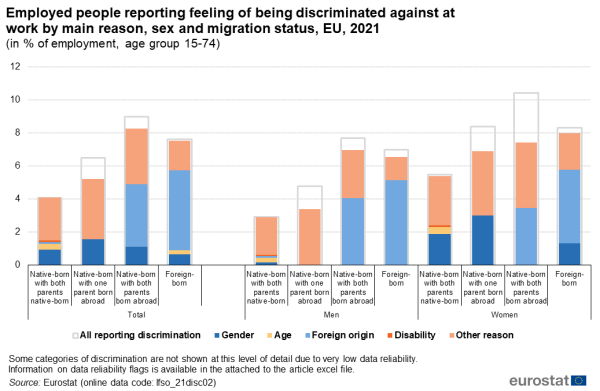
Source: Eurostat (lfso_21disc02)
Figure 8 shows information at country level on the proportion of employed people born abroad or born in the reporting country, but with at least one parent born abroad, facing discrimination at work. The highest percentages, over 10 %, were recorded in Luxembourg, Greece, the Netherlands, Finland and Norway. In most countries for which data are available, the main reason for discrimination mentioned by this group was foreign origin, with the proportion of people giving this as the reason for discrimination reaching around 9 % in the Netherlands, Greece and Norway.
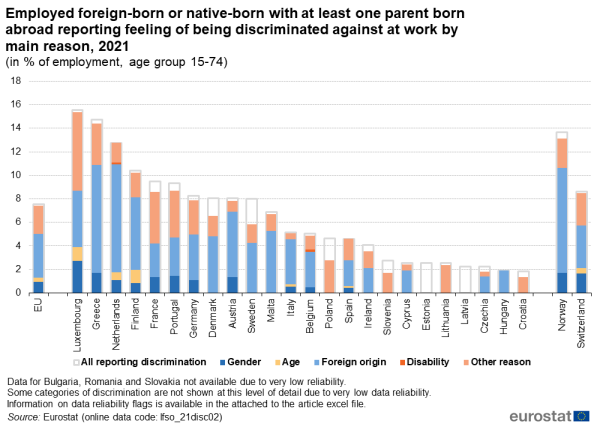
Source: Eurostat (lfso_21disc02)
Almost 8 % of employed men and 9 % of employed women born outside the EU are discriminated against at work
The country of birth has a major impact on the proportion of employed people discriminated against at work. The highest percentages in the EU for both men (7.7 %) and women (8.8 %) were found among people born in a non-EU country (Figure 9). People born in another EU country followed, with 5.4 % for men and 7.5 % for women. By comparison, 3.2 % of men, and 5.8 % of women, born in the reporting country, said they felt discriminated against at work.
The main reason for discrimination against employed people born in a non-EU country or in another EU country was foreign origin. More men (6.0 %) than women (5.0 %) born in non-EU countries reported feeling discriminated against. At the same time, women born in another EU country felt slightly more discriminated against than men (3.4 % versus 3.2 %). However, the overall proportion of women reporting discrimination is higher than that of men, regardless of what country they were born in, since more women than men report feeling discriminated against because of their gender.
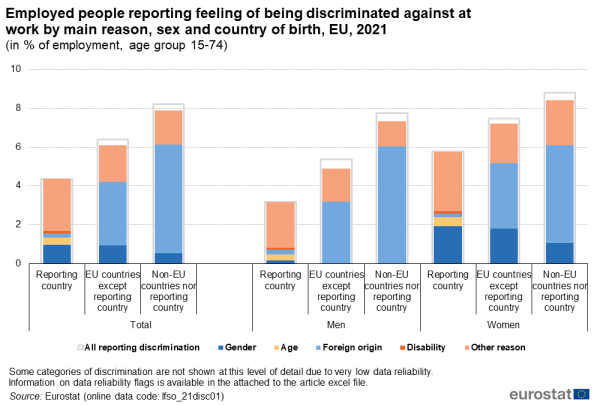
Source: Eurostat (lfso_21disc01)
Sectors of activity, occupation, status and size of enterprise
More than 7% of people working in human health and social work activities reported having experienced discrimination
In the EU, the 3 highest proportions of people who had felt discriminated against at work were recorded in the sectors human health and social work activities (7.1 %), public administration and defence; compulsory social security activities (6.6 %) and the arts, entertainment and recreation (6.1 %) (Figure 10). This proportion falls to under 3 % in the construction (2.8 %) and agriculture, forestry and fishing sectors (2.7 %).
The highest proportion of employed women who said they felt discriminated against was in public administration and defence (7.6 %), financial and insurance activities (7.5 %), transportation and storage and human health and social work activities (both 7.4 %), arts, entertainment and recreation (7.2 %), and information and communication sector (7.1 %). For men, the ranking of the sector of activity is the same as for the total population: human health and social work activities (6.1 %), public administration and defence (5.7 %) and the arts, entertainment and recreation (5.1 %).

(in % of employment, age group 15-74)
Source: Eurostat (lfso_21disc04)
Female technicians and associate professionals and female professionals feel more discriminated against
In 2021, over 5 % of technicians and associate professionals, and of professionals, across the EU said that they felt discriminated against at work (Figure 11). Female technicians and associate professionals (7.3 %) and female professionals (7.1 %) were also recorded as feeling the most discriminated against in these 2 groups.
At the same time, less than 4 % of plant and machine operators and assemblers (3.9%), craft and related trades workers (3.2 %) and skilled agricultural, forestry and fishery workers (2.9 %) said they had experienced discrimination at work.

(in % of employment, age group 15-74)
Source: Eurostat (lfso_21disc03)
The bigger the enterprise, the higher the proportion of employed people feeling discriminated
In 2021, more employees (4.9 %) than self-employed people (3.7 %) reported feeling discriminated against at work, as Figure 12 shows.
The enterprise size also seems to affect the proportion of people who report feeling discriminated against: the bigger the enterprise, the more people feel discriminated against – from 4.1 % in enterprises that employ fewer than 50 people, to 6.9 % in enterprises that employ over 250.

(in % of employment, 15-74)
Source: Eurostat (lfso_21disc02) and (lfso_21disc04)
Source data for tables and graphs
Data sources
The European Union Labour Force Survey (EU-LFS) is the largest European household sample survey providing quarterly and annual results on labour market characteristics of people.
EU-LFS covers the resident population, defined as all people usually residing in private households.
‘Usual residence’ means the place where a person normally spends the daily period of rest, regardless of temporary absences for purposes of recreation, holidays, visits to friends and relatives, business, medical treatment or religious pilgrimage. The following persons alone are considered to be usual residents of a specific geographical area:
- (a) those who have lived in their place of usual residence for a continuous period of at least 12 months before the reference time; or
- (b) those who arrived in their place of usual residence during the 12 months before the reference time with the intention of staying there for at least one year.
Where the circumstances described in point (a) or (b) cannot be established, ‘usual residence’ can be taken to mean the place of legal or registered residence.
The concept of migration used in this article refers to people residing in a EU Member State and born in another country (inside or outside the EU). It consequently excludes people coming back to their country of birth after having resided in another country for at least 12 months.
Since 1999, an inherent part of EU-LFS has been the modules. These were called ‘ad hoc modules’ until 2020. From 2021 onwards, they are called either ‘regular modules’ when the variables have an 8-yearly periodicity or ‘modules on an ad hoc subject’ for variables not included in the regular datasets. In 2021, EU-LFS included a regular module on the labour market situation of migrants and their immediate descendants. From that year onwards, this module will be conducted regularly every eight years under Regulation (EU) 2019/1700.
For further information on the EU-LFS modules, please refer to the article on this subject.
Coverage: The 2021 EU-LFS module on the labour market situation of migrants and their immediate descendants covers all European Union Member States and the EFTA Member States Norway and Switzerland. For Cyprus, the survey covers only the areas of Cyprus controlled by the Government of the Republic of Cyprus.
European aggregates: EU refers to the sum of the 27 EU Member States. If data are unavailable for a country, the calculation of the corresponding aggregates takes into account the data for the same country for the most recent period available. Such cases are indicated.
The level of education refers to the educational attainment level, i.e. the highest level of education successfully completed. Low level of education refers to ISCED levels 0-2 (less than primary, primary and lower secondary education), medium level refers to ISCD levels 3 and 4 (upper secondary and post-secondary non-tertiary education) and high level of education refers to ISCED levels 5-8 (tertiary education).
Context
The continued development and integration of EU migration policy remains a priority of the Union in order to meet the challenges and harness the opportunities that migration represents globally. The integration of nationals of non-member countries legally living in the EU Member States has gained increasing importance in the EU agenda in recent years.
There is a strong link between integration and migration policies since successful integration is necessary for maximising the economic and social benefits of immigration, for individuals as well as societies. EU legislation provides a common legal framework regarding the conditions of entry and stay and a common set of rights for certain categories of migrants. More information on the policies and legislation in force in this area can be found in an introductory article on migrant integration statistics.
The Temporary Protection Directive, which was adopted following the conflicts in former Yugoslavia, was triggered for the first time by the Council in response to the unprecedented Russian invasion of Ukraine on 24 February 2022 to offer quick and effective assistance to people fleeing the war in Ukraine. Indeed, Russia’s military invasion of Ukraine has created a situation of mass arrivals of displaced people from Ukraine unable to return to their homes.
In this context, the EU-LFS 8-yearly regular module on the labour market situation of migrants and their immediate descendants implemented in 2021 can bring crucial information on the labour market integration and level of skills and qualification of the migrants as well as on obstacles and discrimination that migrants can face on the EU labour market. This could help EU policy-makers in adjusting their migration and integration policies.
Direct access to
See also
- Main characteristics of foreign-born people on the labour market
- Main obstacles for foreign-born people to enter the labour market
- Employment - annual statistics
- Unemployment statistics and beyond
- Labour market slack - employment supply and demand mismatch
- All articles on employment
- Migrant integration statistics — online publication
- Foreign-born people and their descendants
- Migration and migrant population statistics
Dedicated section
Methodology
Publications
- Labour force survey in the EU, EFTA and candidate countries — Main characteristics of national surveys, 2020, 2022 edition
- Quality report of the European Union Labour Force Survey 2020, 2022 edition
- EU labour force survey — online publication
ESMS metadata files and EU-LFS methodology
- Employment and unemployment (Labour Force Survey) (ESMS metadata file — employ_esms)
- LFS ad-hoc modules (ESMS metadata file — lfso_esms)
- Labour force survey in the EU, EFTA and candidate countries — Main characteristics of national surveys, 2020, 2022 edition
- Quality report of the European Union Labour Force Survey 2020, 2022 edition
- EU labour force survey — online publication
- Migrant integration statistics — online publication
